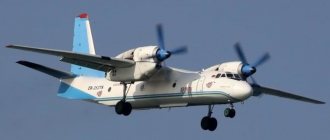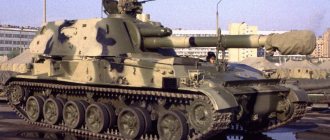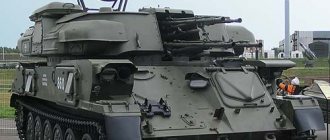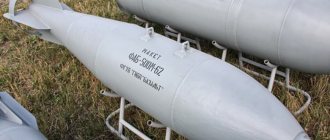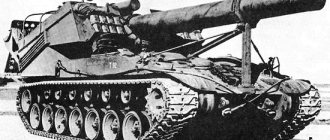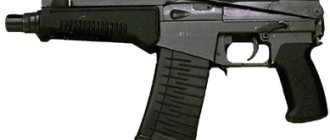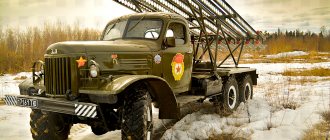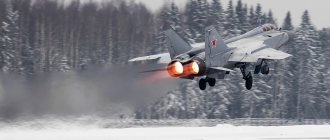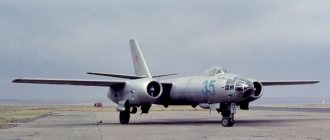Video of the 2S1 “Gvozdika” howitzer during an exercise
At the same time, all the shortcomings of wartime self-propelled guns were taken into account and, if possible, eliminated: small horizontal gun aiming angles, a rather low rate of fire, limited visibility from fixed conning towers. As a result, several cars appeared, which were given names: “Carnation”, “Acacia”, “Tulip”, “Hyacinth”. “Gvozdika” was put into service in 1971 and was intended to eliminate enemy personnel and destroy enemy fortifications.
The vehicle was placed on the chassis of an MT-LB tractor. Rubber-metal tracks and rollers with individual torsion bar suspension ensured good maneuverability and maneuverability of the vehicle. The hull is completely sealed, and movement over water obstacles is carried out by rewinding tracks with rubber-metal hinges. The machine is capable of reaching speeds of up to 4.5 km/h on water, as well as crossing bodies of water up to 300 m wide with a wave height of up to 150 mm and a current speed of no more than 0.6 m/s.
The body of the self-propelled gun is made of steel sheets. The Gvozdika's bulletproof armor can withstand a 7.62 mm B-32 rifle bullet from a distance of 300 m. The driver's cabin and engine compartment are located in the front of the hull, and the fighting compartment is in the rear. The turret, which rotates 360* using an electric or manual drive, houses the commander, gunner and loader. The machine is equipped with a V-shaped 8-cylinder four-stroke diesel engine YaMZ-238V. The gearbox includes 11 forward and two reverse speeds. Fuel tanks with a total capacity of 550 liters are located in the walls of the hull sides, sequentially connected to each other, three on each side.
“Gvozdika” is armed with a D-32 howitzer with a monoblock barrel with a two-chamber muzzle brake and an ejector to remove residual powder gases. To facilitate loading the howitzer, an electromechanical type loading mechanism is used. If shells lying on the ground are taken for firing, they are fed into the fighting compartment using a transport device through the large rear door. The vertical aiming angles of the howitzer barrel range from -3 to +70°. The firing range varies from 4070 m to 15200 m. When firing from the ground, the self-propelled gun is capable of firing 4-5 rounds per minute, and from the side - 1-2 rounds per minute. The fire control system consists of a PG-2 periscopic sight, panoramic and optical sights.
The gun's ammunition includes 35 high-explosive fragmentation and five cumulative separately loaded projectiles. In this case, a wide range of projectiles is used: lighting, propaganda, chemical, smoke, electronic countermeasures projectiles and with special arrow-shaped striking elements, cumulative, high-explosive fragmentation. In 1967, designers worked on creating howitzers for cap-loading self-propelled guns: D-16 and D-16M, but these guns were not included in the series.
Combat use of ISU-122
ISU-122 was used in all functional areas of self-propelled artillery. Together with other heavy self-propelled guns SU-152 and ISU-152, it served as a powerful assault gun, tank destroyer and self-propelled howitzer. However, all these vehicles had different trends in combat use: the SU/ISU-152 gravitated more toward the role of an assault gun, and the ISU-122 toward the role of a tank destroyer. The 122-mm A-19S or D-25S gun fired a 25-kg BR-471 sharp-headed armor-piercing projectile with a muzzle velocity of 800 m/s. This was enough to penetrate the armor of any representative of the Wehrmacht armored vehicles, with very rare exceptions. Only the frontal armor of the "Elephant"/"Ferdinand" was not penetrated by the BR-471, and the armor of the "Royal Tiger" tank, despite more favorable angles of inclination, was often cracked by hits from the BR-471 due to its poor quality. However, due to its high kinetic energy, the BR-471 often damaged heavily armored targets without penetrating the armor, disabling the engine and gearbox with mechanical shock. The 122-mm gun had very high armor-piercing potential, but the BR-471 did not allow it to be fully revealed. An improved version of the blunt-headed armor-piercing projectile with a ballistic tip, the BR-471B, was developed in early 1945, but went into mass production after the end of the war. Reports from the battlefields also noted that powerful OF-471 and OF-471N high-explosive steel cannon grenades with a screw head with subsequent installation of the RGM fuse for high-explosive action also have good effects on enemy armored targets. They also had a mass of 25 kg, a muzzle velocity of 800 m/s and were supplied with 3.6-3.8 kg of TNT, respectively. The mechanical shock and subsequent explosion was often enough to disable the target without penetrating the armor.
Soviet self-propelled gun ISU-122 with an anti-aircraft 12.7-mm DShK machine gun mounted on the armored cabin at the intersection of Stiftswinkel and Am Holzraum streets in Danzig (now Gdansk in Poland). Now the streets are called ul. Robotnicza and ul. Stefana Jaracza.
When breaking through fortified zones and in urban battles, the ISU-122 was used as an assault gun, but with less efficiency compared to the SU/ISU-152. But in general, the ISU-122 deserved a good rating in this role - OF-471 was effective against field and long-term fortifications, openly located and entrenched infantry, and fortified buildings. In urban battles, the long reach of the 122 mm cannon often made it difficult to maneuver in tight spaces.
The ISU-122 was rarely used as a self-propelled howitzer, despite its maximum firing range exceeding 14 km. Typically, ISU-122 fired from closed positions in the absence of towed artillery support during quick breakthroughs, when the towed guns did not have time to advance behind the tank and mechanized units of the Red Army.
Self-propelled gun ISU-122S in ambush. Hungary.
Modifications of ISU-122
Officially, there were two serial modifications of the self-propelled gun - ISU-122 with a 122-mm gun with a piston bolt and ISU-122S with a 122-mm D-25S gun with a wedge bolt. These variants are easily distinguishable visually by the smaller armored mask of the gun and the presence of a two-chamber muzzle brake on the ISU-122S. However, in addition to these differences, production vehicles had other, less noticeable design features. The serial ISU-122 had different guns, see section Description of the design; the front of the armored hull could also differ in manufacturing technology:
– ISU-122, based on the IS tank produced in 1943, had solid frontal hull armor;
– ISU-122, based on the IS tank produced in 1944, had frontal hull armor welded from two rolled armor plates. This version of the self-propelled gun was distinguished by an increased thickness of the gun mantlet in comparison and more capacious fuel tanks.
Since October 1944, the ISU-122 began to be equipped with a 12.7-mm DShK anti-aircraft machine gun. A number of previously produced vehicles also received this machine gun during repairs.
Soviet self-propelled guns ISU-122 on the march. 1st Ukrainian Front, 1945.
Scheme 2S1 “Carnation”
Due to its light weight, the self-propelled gun can be transported using An-12, An-124 and Il-74 aircraft. In this case, the reduction in height is achieved by lifting and securing the road wheels (from the second to the seventh) with special devices. This vehicle has long been and remains in service with all armies of the Warsaw Pact countries to this day. Today, Gvozdika* has a laser-guided projectile, Kitolov-2, specially designed for self-propelled guns. The projectile is capable of hitting stationary and moving targets with a high degree of probability.
SAU 2S5 Giatsint-S – video
https://youtube.com/watch?v=gNJYYQDxkGA
Ammunition for the guns was specially developed, since there were no rounds interchangeable with the Hyacinth in the Soviet Army yet. The first pilot batch of Giatsint-S vehicles was produced in 1976. Serial production of these self-propelled guns began almost immediately. The self-propelled gun is designed to fight heavy self-propelled artillery and enemy tanks, counter enemy batteries, destroy long-term firing points and field structures, as well as suppress the rear and control points of the opposite side.
The self-propelled gun received a tracked chassis similar to the 2SZ Akatsiya chassis. The vehicle is an open type, so the gun is mounted on the rear of the chassis without a turret. The Hyacinth is given additional stability by a folding base plate, so it is almost impossible to fire while moving.
2S5 has a relatively small size, so it is easy to transport, including by air. The armored hull protects the crew from bullets and shrapnel. The self-propelled gun has good cross-country ability and maneuverability, so it is easy to change its position. In addition, with the help of built-in bulldozer equipment, it is able to quickly dig a trench for itself. It takes only about 4 minutes to move from the traveling position to the combat vehicle.
The artillery part of the Giatsint self-propelled gun is a 152-mm 2A37 cannon, the barrel of which consists of a monoblock pipe, a breech and a muzzle brake screwed onto the pipe and absorbing recoil energy by 53%. The gun has a semi-automatic bolt. Refilling is carried out in two stages using an electrically driven chain rammer: the projectile, then the cartridge case. The use of a loading mechanism made it possible to increase the rate of fire of the gun to 6 rounds per minute. Its pointing angle in the horizontal plane is 30′, and in the vertical plane it varies from -2.5 to +58″.
The gun's ammunition includes 30 rounds of separate cartridge loading, including high-explosive fragmentation projectiles of a new type with an improved aerodynamic shape, active-reactive projectiles and adjustable "Krasnopol" with a semi-active laser homing system. According to Western printed sources, the vehicle's ammunition also includes a shot with low-power nuclear ammunition of 0.1-2 kt. In addition, completely new 152-mm shells are being developed in Russia. The gun's ammunition is located inside the body. Shells and charges are fed from the self-propelled gun manually, and an electromechanical machine completes the loading cycle.
The implement is equipped with sector lifting and rotating mechanisms, as well as a pneumatic pusher balancing device. The gun rotates using a machine mounted on a chassis pin. It also has a light shield that covers the gunner and part of the mechanisms from bullets, small fragments and the effects of a muzzle gas wave when firing. The gun is aimed using sighting devices, such as the BM-21 mechanical sight with a PG-1M panorama and the OP4M-90A optical sight.
The 2S5 “Gyacinth” has proven itself well during operation in units and performed well during combat operations in Afghanistan. Reliable, lightweight and mobile, it has repeatedly received good reviews at international arms exhibitions. Despite the fact that the gun is already somewhat outdated, it is nevertheless the longest-range Russian-made gun, second only to the 203-mm 2S7 Pion self-propelled gun.
Organizational structure
The 2S5 self-propelled gun entered service with artillery regiments and brigades of the combined arms armies of the USSR Ground Forces to replace the M-46 and M-47 guns. Each artillery brigade consisted of 5 divisions (4 cannon-self-propelled artillery and 1 reconnaissance), each artillery division consisted of three batteries. The artillery batteries consisted of six 2S5 self-propelled guns (a total of 18 guns in the division), but some divisions had 4 batteries of 6 152 mm guns or 3 eight-gun batteries (that is, 24 guns in the division).
Combat use
The 2S5 self-propelled gun received its baptism of fire during the war in Afghanistan. 152-mm high-explosive fragmentation shells made it possible to guarantee the destruction of any enemy fortification. They were used to a limited extent as part of battalion tactical groups in the First Chechen Campaign.
Tactical and technical characteristics of the self-propelled gun 2S1 “Gvozdika”
Combat weight, t……………15.7 Layout……………front-engine Crew, people…………4
Overall dimensions 2S1 “Gvozdika” Body length 7260mm; Length with gun forward 7260mm; Case width 2850mm; Height 2725mm; Base 4445mm; Track 2500mm; Ground clearance 400mm Reservation Armor type………..rolled steel, bulletproof Hull forehead, mm/deg……………15 Turret forehead, mm/deg……………20
Armament 2S1 “Gvozdika” Caliber and brand of gun……………122-mm 2A31 Type of gun………rifled howitzer Barrel length, calibers……………35.0 Gun ammunition……………40 VN angles, deg……………−3…+70° GN angles, deg………360° Firing range, km up to……………15.2
Engine YaMZ-238N; Engine power 300 l. With. Speed on the highway, km/h……………60 Speed on rough terrain, km/h……………26—32; 4.5 afloat Cruising range on the highway, km……………500 Fuel tank capacity, l……………550
The difference between self-propelled guns and towed artillery
Self-propelled artillery mounts have both advantages and disadvantages in comparison with towed guns.
The advantages include:
- Higher mobility compared to towed guns, speed of deployment and collapse of the firing position.
- In the case of a closed conning tower, tower or armored fence, the crew is more protected from enemy fire.
- The presence of a power plant makes it possible to mechanize the operations of pointing, loading the gun and manipulating ammunition.
- The presence of a self-propelled chassis allows the installation of self-excavation equipment.
- Automation of loading and guidance makes it possible to significantly increase the rate of fire of a gun and implement it, bringing the tactical capabilities of cannon artillery closer to multiple launch rocket systems.
- If there is a closed wheelhouse or cabin, it is possible to protect the crew from the damaging factors of weapons of mass destruction and adverse weather conditions.
- Self-propelled artillery units are less dependent on auxiliary vehicles.
- On anti-aircraft self-propelled artillery installations, the presence of a self-propelled chassis allows the installation of radar stations for target detection and guidance.
- The ability to use artillery systems that are too bulky for a towed chassis.
Disadvantages in comparison with towed artillery are:
- High cost of production and operation.
- Limited strategic and operational mobility.
- Dependence on the availability of fuels and lubricants and repair facilities.
- If the gun is installed in a closed wheelhouse or turret, there will be cramped working conditions for the crew and gas pollution in the fighting compartment.
- A more limited choice of firing positions is associated with limited maneuverability and the difficulty of camouflaging self-propelled guns.
High autonomy, the ability to quickly change positions, and the presence of armor ensure high survivability of self-propelled guns on the battlefield, their greater resistance to counter-battery fire, which partially compensates for their high cost.
The use of towed artillery is greatly complicated in the context of the use of weapons of mass destruction, which led to the massive development of self-propelled guns with closed fighting compartments in the post-war period.
At the same time, self-propelled guns (especially heavy assault guns) are much larger in size and weight compared to their towed counterparts. This significantly complicates their transportation by rail and air transport, overcoming water obstacles, and requires a repair base and significant reserves of fuel and lubricants.
The ability of self-propelled guns to move as part of mechanized units allows one to significantly increase their firepower in offensive operations, and in defense to quickly respond to enemy movements and breakthroughs.
Description
Perennial garden carnation (lat. Dianthus caryophyllus) or Dutch carnation is an ornamental plant of the Clove family. The flower prefers moist, fertile soils and is found in the temperate climate of central Europe. The typical species is a medium-sized plant, the stem height can be up to 80 cm. The leaves are entire, simple, covered with a light gray-greenish coating. The length of the leaves is 12–15 cm. The flowers are single buds or collected in umbrellas with a diameter of 38–40 cm, up to 5 pieces. Blooms profusely for 2–3 weeks. The flowering period is from early June to late October.
The plant looks like a small shrub. The stem is strong, the leaves are mostly narrow. After flowering, seed pods appear in the axils of the stems. The fruits are brown or brown in color. Depending on climatic conditions, the plant can bloom in one place for 2-3 seasons, after which it must be replanted. The rhizome of garden carnation is poorly developed and lies in the ground no deeper than 10–20 cm.
All Dianthus are herbaceous plants. Depending on the climate and growing conditions, they can produce two types of shoots: with peduncles and vegetative ones. Carnations differ in color, number of buds and types of petals. Cultivated garden varieties are represented by a wide color palette - from soft pink to bright red or purple.
History of creation
Assault and anti-tank self-propelled guns appeared in service with the USSR army in the 1940s. It cannot be said that they made a decisive contribution to the victory (the championship still belongs to tanks), but they were very effective in supporting infantry and advancing tanks. With the beginning of the Cold War, the potential enemy acquired sophisticated 105 mm artillery systems, which were superior to Soviet self-propelled guns in many respects.
But the USSR doctrine was aimed at the use of missiles and self-propelled guns were not developed. After Khrushchev left office, a doctrine emerged among sober minds that a global nuclear war was impossible. The possibility of destroying not only the enemy, but also oneself is too great. But the use of destructive weapons for tactical purposes is quite likely. In this sense, the use of self-propelled guns was one of the best ways to deliver a tactical nuclear charge to the right place.
Based on this statement, the development of a new self-propelled gun, called the 2S1 “Gvozdika” self-propelled gun, began, taking into account the possibility of using such charges.
By the decision of the Communist Party and the decree of the Union government, the development of a 122 mm caliber artillery system began in 1967.
This decision was based on the research base of VNII-100. It was these studies that determined the basic characteristics of the future self-propelled howitzer.
The research institute proposed three chassis options: BMP-1, MT-LB tractor and Object-124. They chose a tractor, on the basis of which the Gvozdika self-propelled gun was designed. The tractor plant in Kharkov was tasked with developing a new system.
1969 began testing four prototypes of 122 mm Gvozdika and 152 mm 2S3. The choice was made on the Gvozdika. In 1970, the USSR government, after a year of testing and necessary modifications, adopted the Gvozdika self-propelled gun.
The new self-propelled gun began to arrive in military units, and the crews gradually mastered this system. Serial production was finally mastered in 1971. It was produced in Poland (since 1971) and Bulgaria (since 1979). In 1991, the self-propelled gun was no longer produced. In total, about ten thousand cars have been produced since 1970.
Gladiolus
Remember the distant Soviet times. On September 1, one part of the country brought bouquets of asters to school, and the other – gladioli. Over time, they were replaced by assorted overseas beauties. And these flowers are also becoming less and less common in flower beds.
However, true connoisseurs of gladioli have remained faithful to their favorites and continue to plant flower beds with more and more new varieties. Unfortunately, they do not bloom for long - 1-2 weeks. If you want to admire the flowers longer, simply plant the corms not at the same time, but at short intervals.
Flowers can last in a vase for about 2 weeks. To extend this period, you need to know how to cut gladioli correctly. This should be done at a time when the flowers are filled with moisture: early in the morning or in the evening. On a cloudy day, cutting can be done at any time. Focus on the first bud: it should be half-open. When cutting, remove only the stem with the inflorescence, and try to leave the leaves on the plant. In this case, the corms will be able to ripen normally, and next year the flowering of gladioli will again be abundant and long-lasting.
Excerpt characterizing 2S12
– Your father, a man of the old century, obviously stands above our contemporaries, who so condemn this measure, which restores only natural justice. “I think, however, that there is a basis in these condemnations...” said Prince Andrei, trying to fight the influence of Speransky, which he was beginning to feel. It was unpleasant for him to agree with him on everything: he wanted to contradict. Prince Andrei, who usually spoke easily and well, now felt difficulty in expressing himself when speaking with Speransky. He was too busy observing the personality of the famous person. “There may be a basis for personal ambition,” Speransky quietly added his word. “Partly for the state,” said Prince Andrei. “What do you mean?...” said Speransky, quietly lowering his eyes. “I am an admirer of Montesquieu,” said Prince Andrei. - And his idea that le principe des monarchies est l'honneur, me parait incontestable. Certains droits et privileges de la noblesse me paraissent etre des moyens de soutenir ce sentiment. [the basis of monarchies is honor, it seems to me beyond doubt. Some rights and privileges of the nobility seem to me to be a means of maintaining this feeling.] The smile disappeared on Speransky’s white face and his physiognomy benefited a lot from this. He probably found Prince Andrei’s idea interesting. “Si vous envisagez la question sous ce point de vue, [If that’s how you look at the subject,” he began, pronouncing French with obvious difficulty and speaking even more slowly than in Russian, but completely calmly. He said that honor, l'honneur, cannot be supported by advantages harmful to the course of service, that honor, l'honneur, is either: the negative concept of not doing reprehensible acts, or a well-known source of competition for obtaining approval and awards expressing it. His arguments were concise, simple and clear. The institution that maintains this honor, the source of competition, is an institution similar to the Legion d'honneur [Order of the Legion of Honor] of the great Emperor Napoleon, which does not harm, but promotes the success of the service, and not the advantage of class or court. “I don’t argue, but it cannot be denied that the court advantage achieved the same goal,” said Prince Andrei: “every courtier considers himself obliged to bear his position with dignity.” “But you didn’t want to use it, prince,” said Speransky, smiling, indicating that he wanted to end the argument, which was awkward for his interlocutor, with courtesy. “If you do me the honor of welcoming me on Wednesday,” he added, “then I, after talking with Magnitsky, will tell you what may interest you, and in addition I will have the pleasure of talking with you in more detail.” “He closed his eyes, bowed, and a la francaise, [in the French manner], without saying goodbye, trying to be unnoticed, he left the hall. During the first time of his stay in St. Petersburg, Prince Andrei felt his entire mindset, developed in his solitary life, completely obscured by those petty worries that gripped him in St. Petersburg. In the evening, returning home, he wrote down in a memory book 4 or 5 necessary visits or rendez vous [meetings] at the appointed hours. The mechanism of life, the order of the day in such a way as to be everywhere on time, took up a large share of the energy of life itself. He did nothing, didn’t even think about anything and didn’t have time to think, but only spoke and successfully said what he had previously thought about in the village. He sometimes noticed with displeasure that he happened to repeat the same thing on the same day, in different societies. But he was so busy all day that he didn’t have time to think about the fact that he didn’t think anything. Speransky, both on his first date with him at Kochubey’s, and then in the middle of the house, where Speransky face to face, having received Bolkonsky, spoke with him for a long time and trustingly, made a strong impression on Prince Andrei. Prince Andrei considered such a huge number of people to be despicable and insignificant creatures, he so wanted to find in another the living ideal of the perfection for which he was striving, that he easily believed that in Speransky he found this ideal of a completely reasonable and virtuous person. If Speransky had been from the same society from which Prince Andrei was, the same upbringing and moral habits, then Bolkonsky would soon have found his weak, human, non-heroic sides, but now this logical mindset, strange to him, inspired him with respect all the more that he did not quite understand it. In addition, Speransky, either because he appreciated the abilities of Prince Andrei, or because he found it necessary to acquire him for himself, Speransky flirted with Prince Andrei with his impartial, calm mind and flattered Prince Andrei with that subtle flattery, combined with arrogance, which consists in silent recognition his interlocutor with himself, together with the only person capable of understanding all the stupidity of everyone else, and the rationality and depth of his thoughts.
Design
The layout of the body of this artillery system was made according to the turret design. Everything is welded from rolled steel sheets. The body itself is absolutely sealed, and the thickness of the armor plates is 20 mm. This is fairly reliable protection against shrapnel and bullets, but not against shells. The engine compartment is located on the right side, where the driver-mechanic seat is also located.
The fighting compartment is located in the middle and stern. There is a turret on the hull, and a gun in it. There are charges and loader in the turret on the right side. On the left is the gunner and sight for precise aiming. The commander's place is behind the gunner. The commander has his own rotating turret with a hatch for visual control. In the niche of the tower itself, cumulative shells and charges for them are placed. The remaining ammunition is located at the stern.
The 2S1 self-propelled gun has a special hatch through which it is possible to receive shells directly from the ground.
Chassis. It is based on a modified MT-LB chassis. It was well redesigned, installing a couple of additional road wheels. But the number of rubberized skating rinks has increased to seven pairs. There are guide wheels at the rear and driving wheels at the front. The caterpillar is assembled from links (tracks). The links are quite small (350*111), connected by metal fingers.
With a track width of 350 mm and a weight of 15.7 tons, the machine feels confident on any ground. The Gvozdika artillery system has an individual torsion bar suspension. Hydraulic shock absorbers are installed on the seventh and first road wheels.
Engine and transmission. The vehicle is equipped with a YaMZ-238N engine with a power of 300 hp. Runs on diesel fuel. The engine is V-shaped, 8-cylinder, four-stroke, liquid-cooled. Gas turbine supercharging. As for the transmission, it is dual-flow and mechanical. There are two rotation mechanisms and they are planetary-friction. There are six forward gears and one reverse gear.
Armament. The 122 mm rifled howitzer is the basis of the installation's firepower.
The muzzle brake, ejector, breech and pipe are connected into a barrel more than 4 meters long. There are 34 grooves inside the barrel. This weapon uses a vertical wedge bolt. There is a semi-automatic re-cocking mechanism.
To prevent the projectile from falling out in cases where the barrel is at high elevation angles, a special tray with a retention device is installed.
The recoil device has a special hydraulic brake, of the spindle type. There is also a pneumatic knurling device with air or nitrogen filling. A compensator is installed on the rollback brake.
Surveillance and communication equipment. TKN-3B, a sight that is located on the commander's seat. The OU-3GA2 sight is installed to carry out night surveillance of the area. TNPO-170A, a periscope, prismatic type sight, and 1OP40 panoramic type, both are located at the gunner's position. OP5-37, for firing from cover. The MK-4 rotating type is located on the right side of the turret. The mechanic has a TNPO-170A device for observation during the day and a TVN-2B for night observation.
At the driver-mechanic's place there is a glass with an armored cover for direct observation of the terrain. R-123M radio station with the help of which external communication is carried out. It operates on VHF waves, with a range of up to 28 km. For communication between the crew, the R-124 device is installed in the self-propelled gun.
Modifications
Various military equipment was manufactured on the basis of the 2S1 “Gvozdika” (122 mm) installation:
- Model of the 2S8 Astra self-propelled mortar. The experimental weapon was designed for ground units. Activities on the project were discontinued due to the release of a rifled automatic analogue 2A51.
- Experimental self-propelled 100-mm gun 2S15 “Norov”. Work on creating the sample took a long time. By the time the tests were completed, NATO had tanks against which these weapons were ineffective. The project was canceled.
- Self-propelled 120-mm gun 2S17 “Nona”. The use of the unit was intended as an alternative to the mortar, but with the advent of the automatic model SAO 2S31, the project became irrelevant.
- Tracked version of 9P139 "Grad-1". The vehicle was put into service in 1976 in a small production batch. Large-scale production was planned to be organized in Bulgaria, but production was never established.
- Mine clearance machine UR-77 “Meteorite”. Mass-produced since 1978.
- Lightweight multi-purpose chassis "Object-29".
- Universal tractor-transporter 2S1-N, designed for transporting personnel and cargo in a closed body.

